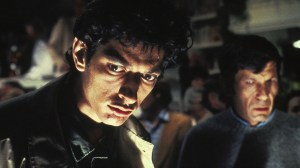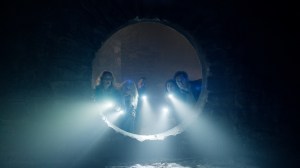
DC Comics resumed print publication this week releasing a handful of new comics, including Daphne Byrne #4. This horror series from writer Laura Marks and artist Kelley Jones tells the story of its titular character as she explores occult forces in the Victorian era following the death of her father. Each issue has ratcheted up the tension surrounding Daphne’s connections to ghostly powers and the all too real tragedy surrounding the Byrne family. The fourth issue brings readers deeper than ever into the darkness, delivering plenty of twists and some of the most frightening comics pages of 2020.
Videos by ComicBook.com
ComicBook.Com reviews editor Chase Magnett interviewed the creative team as their series resumes this week, discussing the comic’s origins, what makes this horror story so effective, and what readers should anticipate as Daphne Byrne builds to its climax. Check out what these masterful storytellers had to share and an exclusive preview of Daphne Byrne #4 below.
ComicBook.Com: One thing that struck me from the very first issue of Daphne Byrne is how it delivers such a distinctive atmosphere, setting, and style from page one. It’s difficult to imagine anyone besides Kelley Jones drawing this story. Would you tell us a little bit about how you both became involved with and developed the project?
Laura Marks: Joe Hill reached out and asked if I had an idea for a horror comic. He said he was curating a new series of original titles for DC. I’ve always wanted to write something about the Spiritualist movement, set in New York during the Gilded Age, and this felt like the perfect opportunity to explore that world and fill it with terrors. The Hill House editorial team did some matchmaking, and I had the great fortune to be paired with Kelley. I completely agree that I can’t imagine anyone else drawing this story!
Kelley Jones: I had mentioned to DC I would be interested in doing some pure horror stories when coming off Batman: Kings of Fear. So, I did a one shot for Lucifer, which went over well in the office as it took place in the same period as Daphne Byrne, which was around the late 1800s. Seeing that, DC sent the treatment for the book to see if I’d be interested. When I read the treatment, the thing that struck me was that it was so different and very frightening. I liked everything I read because it offered many opportunities to draw things that could create real atmosphere and tension. Though I was not familiar with Laura’s work, I really dug her ideas, and it made it easy to say yes. I am always looking for something to draw that I myself would want to read, and this had that factor.
ComicBook: The series is just past its halfway point this week and has already produced some tremendous pages and panels. Would you also be willing to share a bit about your collaborative process in developing the “big” moments and scares of this story?
Marks: I definitely have Kelley in the back of my mind when I’m writing a scene. I always want to give him a visual concept that he’ll love to draw, and save room for some of his spectacular splash pages. But I think the subtler moments he adds, the little creepy surprises, are just as important. One example: the first time we revealed our group of cultists in Issue #3, I had told Kelley they should be “a range of ages and classes.” He took that one step further and drew one of them as a nicely dressed little girl. I thought that was such a wonderfully demented impulse on his part. I immediately started wondering how that little girl got there, and thinking of ways we could use her later in the series…
Jones: For me, the best thing about making this book with Laura is her characters. The scares don’t work if I don’t care about or believe in them. Many things happened when drawing this that just arose in the process. I started drawing some panels from the point of view of the thing that is haunting Daphne, without making those panels obvious to the reader, which adds a weird element without being obvious. That alone adds a creep factor to a page.
When the big moments come in the story, I would try and create many little moments to lead up to them. Heavy little things that would make the flourishes more striking. Decidedly odd points of view, for example, and framing shots that are disorienting. Symbolic things all over the place that, even if not picked up at first, create an unsettling atmosphere. I wanted the horror to be a delightfully awful journey, and one that would hopefully stay even after the book has been read.
ComicBook: I’ve referenced in my reviews that Daphne Byrne embodies some of the literature of its setting and period, featuring some strong Romantic tendencies. Are there any cultural works that you’ve found to be a strong influence or touchstone while crafting the series?
Marks: Kelley and I both work really hard to get the period details right. We found early on that we had a shared love of 19th century ghost stories, by M.R. James and the rest. I’ve always loved the uncanny weirdness of the Brontë sisters. And the specific Old New York setting is inspired by Henry James and Edith Wharton — and by a lot of the architecture I see every day in Brooklyn. Arthur Conan Doyle’s History of Spiritualism was a fun resource, too.
Jones: I want it to be a seen as a dark fairy tale. I imagine it as if it had been a Hammer film directed by Terence Fisher, and try to put that to paper.
ComicBook: Part of that connection, for me, stems from the intense focus on Daphne’s personal experience and her uncertainty about what is real and what is illusion. How have you approached developing an unreliable narrator (and reader’s uncertainty) in comics?
Marks: I do love a story with a strong central POV. It can allow you to build a kind of claustrophobic tension, especially when you’re not quite sure if the character you’re identifying with is going crazy or having a supernatural experience.
Jones: I go at this as if Daphne is surrounded by unreliable narrators, and she’s the only sane one, which by definition makes her insane to everyone else. That’s frightening to me!
ComicBook: Daphne Byrne is part of the Hill House Comics, which has delivered a lot of new horror comics for readers. Are there any particular moments you are proud of from the series so far that showcase how comics can uniquely deliver the genre’s scares and thrills?
Marks: I think I’m most proud of a scene that’s yet to come in Issue #5… it was one of the hardest things I’ve written. And oddly enough, in a series that’s all about supernatural scares, this scene is about a real-life atrocity that happens every day. That’s all I can say about it.
Jones: A couple little scenes stand out to me: Daphne’s mom making the bed and seeing the faces of demons under the bedspread; in the graveyard, the child Satanist; Daphne in the library; Brother’s real appearance; Daphne in her coffin.
ComicBook: There are still two issues left in Daphne Byrne, which we will hopefully get to read soon. What has you excited to see how readers respond to the series’ climax?
Marks: The first three issues were largely about watching this dark entity (who calls himself her “Brother”) worm its way into Daphne’s mind. Now, in the last three issues, they’re so intertwined that Daphne can’t tell where she ends and Brother begins. They’re ready to do some serious damage.
Jones: That readers will worry and care for Daphne, but be very afraid of her.
And now a preview from the newest issue of Daphne Byrne—available today.









